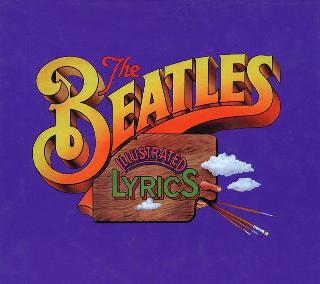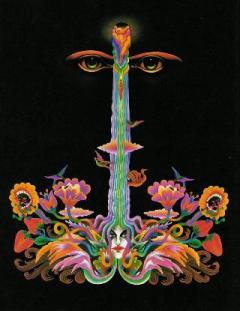Index
Home
Vorige
Julia
Composer(s) : Lennon and McCartney
Year : 1968
Chords/Tabs: Julia
Notes on "Julia" (J)
KEY D Major
METER 4/4
FORM Verse -> Refrain -> Refrain ->
Bridge -> Refrain ->
Verse -> Refrain -> Refrain -> Outro (w/complete ending)
GENERAL POINTS OF INTEREST
Style and Form
- This song is almost agonizingly exquisite in its restrained, laconic
poetry, its combination of suggestive imagery with a reluctance to be
explicit; "silent cloud touch me," indeed.
- Though it is cast in an unadorned and folksy finger picking acoustic
guitar style, the musical text is just as elusive as are the words.
- The formal design is also equivocal; what I label above as "Verse"
and "Refrain," you might prefer to call "Intro" and "Verse." I myself
could argue it either way; heck, but I'll stick with "Verse" and "Refrain"
because of the way the title is repeated like a mantra throughout all
appearances of that section, no matter how many of the other words are
varied.
Melody and Harmony
- There's an ample enough supply of plain old V->I in the harmony
to clearly establish the home key, but the heart of the song is
dominated by "impressionistic" chord changes that involve atypical
root movements and a large share of dissonant tones. This effect
is amplified by the way in which the particular string picking order
often delays the appearance of the root note of the chord until
the middle of the measure in which the chord has nominally changed.
- The tune is confined within the relatively small range of a 6th,
from 'D' up to 'B,' something which enhances that feeling in
the song that something is being held back. Indeed, the leaning
upward to that C# appogiatura at the end of the final couple refrains
(on the words "song of love" -- an important tactical point that it is
reserved for toward the end!) as well as the reach downward to G#,
at the beginning of the bridge provide well needed respite.
- You might say the effect of the restricted melodic range is, itself,
intensified by the B-natural/B-flat cross relationship within the
tune as well as the similar alternation of F# in the tune with F natural,
supplied as the 7th of the g minor chord.
Arrangement
- The arrangement is ultra-simple and recorded ultra sotto-voce. This
kind of ending to the first of the unprecedented two-platter White Album
is intended to be "ironic" in contrast with the manner in which the
song order of the first side emerges. You passively accept the quiet
ending it as inevitable, but if you think about it, you could just as
easily have expected this side of the album to end on an orgasmic note.
- The recording level of this track is so extremely low that, outside
the confines of your own living room, alone in the dark late at night,
you find yourself needing to turn up the volume for this song to a level
that makes many of the other tracks on the album come out way too loud.
The same thing happens with George's
"Long Long Long" for the conclusion
of side 3; an effect that is partially lost in the transfer to the singlesided
CD format.
- John's lead vocal single-tracked for the most part and delivered with
a curiously pale, dead-pan delivery. It is double-tracked only for the
final phrase of each section, and where the formal overlap of one section
to another calls for it.
SECTION-BY-SECTION WALKTHROUGH
Verse
- The verse is nine measures long and built on an AA' poetic
structure of 5 + 4. Note, though, how the final measure of
this section elides with the first measure of the following
section.
|D |b7 |f |- |
D: I vi iii
|D |b7 |f |A D
I vi iii V I
- The b7 chord is a good example of so-called "free dissonance." The
7th comes into play strictly as a matter of the note, 'A,' being
sustained through the entire phrase; it otherwise serves no
harmonic or contrapuntal purpose. The sustaining of the
note 'A' is reinforced by the guitar part's featuring of an
"inverted cuckoo clock" motif reminiscent of the way the note
'F#' is made similarly prominent in "Dear Prudence."
- The root chord progressions are on the weak side, suggesting
a mood of being too tired or upset to get up and fix yourself
a drink; vi -> iii consists of a move of a fourth downward,
analogous to the passive Plagal Cadence (V->I has a more energetic
telioglical feel to it than IV->I, IMHO); iii -> V feels even
weaker because the two chords share two out of three triadic
notes in common.
Refrain
- The refrain is 13 measures long, built out of three phrases in
a 4 + 4 + 5 pattern. Just like the Verse, above, it elides with
the section that follows.
|D |b7 |a 7 |9 |
I vi v
|B |- |g7/9 |- |
V-of-ii iv
|D |b7 |f# |A D
I vi iii V I
- The harmony continues here to be pungent in terms of the coloring
of individual chords, at the same time being unsure of its footing
with respect to root movement from one chord to the next. Examples
abound:
- the reprise of the free b7 in the first and last phrases.
- the move from vi -> *minor* v in a Major key; topped off, no
less, by the free 9/7 embellishment of v.
- the B Major chord at the beginning of the second phrase leads you
to anticipate a modulation toward e minor so strongly that you hear
the previous a minor chord as a pivoting "iv" in the key of e.
- any expectation of the modulation though is abruptly dashed by
the move, next, to a g minor chord. The latter is, first of all,
our old friend, the minor iv in Major key (an especial Lennon favorite).
In this context it creates a double cross-relation with the previous
chord (B-flat/B-natural, F#/F-natural), and another cross-relation
(F-natural/F#) with the following chord. This g minor chord is,
itself, embellished by a yearning 2->3 upward appogiatura, and
is made initially mysterious by the way in which the root note
is delayed until the 3rd beat of the measure; for a couple beats
you half suspect that the chord change is to d minor; not g minor 7.
- BTW, this is probably an appropriate place at which to reiterate
something you've heard me say many times before: Yes, I KNOW that
there's no way that JL (or any other songwriter, for that matter) would
compose the above 13 measures with much, if any, of what I've analyzed
in mind. But STILL, I stand by my conviction that what I've analyzed
is part of what you react to in listening thoughtfully and sensitively
to the music whether you can articulate it or not. Part of the music's
charm is the extremely rapid pace and multiple layers on which all these
details hit you; even if you CAN articulate it, it happens in real
time, much faster than you could keep up with if you tried; kind of
like sex in that way :-)
Bridge
- The bridge fills 10 measures, introduced by a two-measure wind-down
from the previous section. Scan the 10 measures as 4 + 2 + 4:
|D |- |
D: I
f#: VI
|c# |- |D |- |
f#: v VI
|b7 |- |
f#: iv
|f# |- |- |- |
f#: i
D: iii
- Starting with the unusual move to the c# chord, this section provides
a rather weak modulation to the key of the relative minor, f#. I
term it as "weak" because of the continued usage here of the minor v
chord and the plagal cadence.
Outro
- The remainder of the song following the lone bridge is mostly
a repeat of material heard earlier, though some variations call
your attention.
- The subtext of being incapable of articulating one's message completely
in words is nicely painted by the fragmentary nature of the vocal part of
the final verse; completely silent for two separate patches, and wordlessly
humming along for a third. The latter effect is strangely reminiscent of
"All I've Got to Do."
(Right, when's the last time you listened to that
one? Quick -- do you know, off the top of your end on which album it
appears?)
- Best of all, perhaps, is the VERY old fashioned (by Beatles standards)
three-times-you-re-out outro. Note how, in the final verse John initially
drops the f# chord from the last verse, only to restore it for the very,
very, last time around. In hindsight, now that the f# chord is suddenly
omitted, you realize how its presence all along the rest of the way
was yet another wordlessly musical expression of yearning.
- Let's pick it up at measures 9 of the last verse:
"So I sing ... Jul --i-a.
|D |b7 |A |D |
I vi V I
Jul --i-a.
|A |I |
V I
Jul --------- i-a.
|f# |A |D7 |- |
iii V I
- The I7 chord at the end is a final, fitting example of free dissonance.
SOME FINAL THOUGHTS
- "Julia" makes an interesting comparison with
"I'm So Tired," sharing
much of the latter's ennervation but at the same time replacing its
marked tendency toward irritability with a yearning that is sad but
also faithful beyond words.
- You can have even more fun comparing and contrasting "Julia"
with the immediately preceding track,
"I Will." Could this be
yet another one of those cases in which I fancifully hypothesize
that John and Paul might set themselves the challenge of writing
parallel songs based upon a single common denominator?
- In this case the theme of a relationship that is at once paradoxically
intimate-yet-remote, transcendentally essential yet somehow not yet
(alas, maybe impossible to ever be) fully consumated is unimstakably
at the core of both songs. And yet, if you start to consider
side-by-side the musical style and details of the two songs,
you find an insight into the personalities of the two songwriters,
their differences as well as their interdependencies, that is as vivid
and true as the most ample psychological argument you might chose
to make from biographical sources. We've done this before with
song pairs such as
"Paperback Writer/Rain" and
"She Said She Said
/Good Day Sunshine."
Try doing this pair on your own, or let's come
back to it another day.
- And on a related note, consider this: though you probably treasure your
knowledge of the poignant personal history that underlies "Julia" do you
ever stop to ponder how relatively incidental and non-essential that
knowledge is to the effect that the song has upon you? Oh, I understand
how knowing that Julia was John's mum unavoidably adds a new dimension
to your so-called appreciation of the song, but what I'm asking now is
how much *less* does the song speak to your heart in absence of that
knowledge?
Regards,
Alan (awp@world.std.com)
---
"I've only one thing to say to you ... " 030898#145
---
Copyright (c) 1998 by Alan W. Pollack
All Rights Reserved
This article may be reproduced, retransmitted, redistributed and
otherwise propagated at will, provided that this notice remains
intact and in place.
Ook op The Beatles [White Album]:
Ook op Love:
(c) 2024 Serge Girard


 (c) Alan Aldrigde, The Beatles Illustrated Lyrics
(c) Alan Aldrigde, The Beatles Illustrated Lyrics